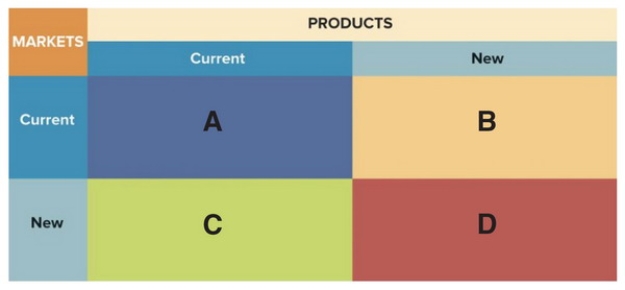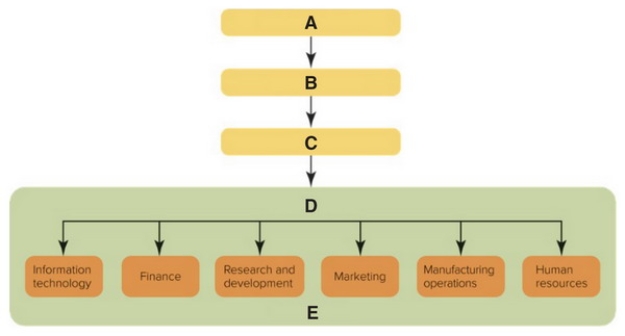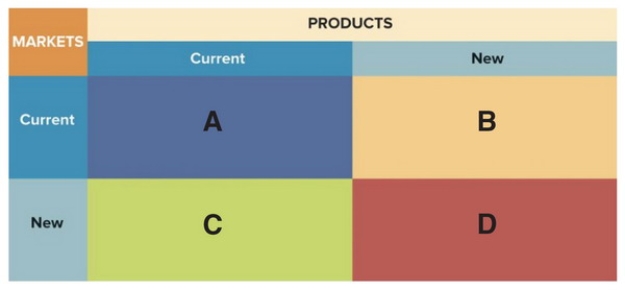A) viable mission.
B) competitive advantage.
C) tactical innovation.
D) core benefit.
E) sales orientation.
Correct Answer

verified
Correct Answer
verified
Multiple Choice
A marketing strategy is the means by which a marketing goal is to be achieved. The two parts that usually characterize a marketing strategy are
A) specific organizational goals and objectives.
B) a detailed marketing plan and a marketing budget.
C) marketing strategies and marketing tactics.
D) a specified target market and a marketing program to reach it.
E) marketing metrics and marketing dashboards to track effectiveness.
Correct Answer

verified
Correct Answer
verified
Multiple Choice
Howard Schultz, the founder of the American coffee chain Starbucks, provides health care for all employees who work over 20 hours per week. This is an example of one of Starbucks' ________ goals.
A) profit
B) market share
C) employee welfare
D) customer satisfaction
E) sales
Correct Answer

verified
Correct Answer
verified
Multiple Choice
 Figure 2-7
-Consider Figure 2-7 above. A Florida-based flashlight company has been extremely successful due in part to the number of hurricanes in Florida that result in power outages. The firm is thinking of expanding its product offerings to include other emergency supplies such as generators and survival kits that include food bars, a water filtration system, and first aid supplies. Although there are nine named hurricanes forecasted for the upcoming year, no one really can predict what will happen. The projected number of hurricanes would fall in which quadrant(s) of the SWOT analysis grid?
Figure 2-7
-Consider Figure 2-7 above. A Florida-based flashlight company has been extremely successful due in part to the number of hurricanes in Florida that result in power outages. The firm is thinking of expanding its product offerings to include other emergency supplies such as generators and survival kits that include food bars, a water filtration system, and first aid supplies. Although there are nine named hurricanes forecasted for the upcoming year, no one really can predict what will happen. The projected number of hurricanes would fall in which quadrant(s) of the SWOT analysis grid?
A) A
B) B
C) C
D) D
E) both C and D
Correct Answer

verified
Correct Answer
verified
Multiple Choice
At the functional level, the marketing department
A) solicits talent from all levels of the organization for strategic corporate planning sessions.
B) promotes its goals to the organization's stakeholders.
C) looks outward, in part by listening to customers.
D) develops the corporate culture.
E) defines the overall strategic direction of the organization.
Correct Answer

verified
Correct Answer
verified
Multiple Choice
Which of the following is not one of the four principles that underlie the strategic marketing process?
A) Competitors change and react.
B) Customers are different.
C) Organizational resources are limited.
D) Customers change.
E) Management changes.
Correct Answer

verified
Correct Answer
verified
Multiple Choice
 Figure 2-1
-In Figure 2-1 above, B represents the ________, the highest of the three levels of strategy in an organization.
Figure 2-1
-In Figure 2-1 above, B represents the ________, the highest of the three levels of strategy in an organization.
A) functional level
B) board of directors
C) corporate level
D) CEO
E) strategic business unit level
Correct Answer

verified
Correct Answer
verified
Multiple Choice
An organization's foundation includes which element?
A) Mission
B) Business definition
C) Goals
D) Strategic levels
E) Offerings
Correct Answer

verified
Correct Answer
verified
Multiple Choice
Lands' End is primarily a catalog and online clothing retailer. This means that traditional department stores, mass merchandisers, specialty shops, and other catalog retailers are considered to be Lands' End's
A) consideration set.
B) industry.
C) competitors.
D) target market.
E) stakeholders.
Correct Answer

verified
Correct Answer
verified
Multiple Choice
Business portfolio analysis refers to
A) a tool that helps a firm search for growth opportunities from among current and new markets as well as current and new products.
B) a technique that managers use to graphically track their firm's strategic business units as though they were a single expense in order to identify cost-cutting measures.
C) a technique that managers use to quantify performance measures and growth targets to analyze their firm's strategic business units as though they were a collection of separate investments.
D) an analysis that uses percentage points of market share as the common basis of comparison to allocate marketing resources effectively for different product lines within the same firm.
E) a tool that seeks opportunities by finding the optimum balance between marketing efficiencies versus R&D-manufacturing efficiencies.
Correct Answer

verified
Correct Answer
verified
Multiple Choice
 Figure 2-7
-Consider Figure 2-7 above. A Florida-based flashlight company has been extremely successful due in part to the number of hurricanes in Florida that result in power outages. The firm is thinking of expanding its product offerings to include other emergency supplies such as generators and survival kits that include food bars, a water filtration system, and first aid supplies. The firm has a great reputation with its flashlights and does not want to ruin it. The company's reputation would fall in which quadrant(s) of the SWOT analysis grid?
Figure 2-7
-Consider Figure 2-7 above. A Florida-based flashlight company has been extremely successful due in part to the number of hurricanes in Florida that result in power outages. The firm is thinking of expanding its product offerings to include other emergency supplies such as generators and survival kits that include food bars, a water filtration system, and first aid supplies. The firm has a great reputation with its flashlights and does not want to ruin it. The company's reputation would fall in which quadrant(s) of the SWOT analysis grid?
A) A
B) B
C) C
D) D
E) A and C
Correct Answer

verified
Correct Answer
verified
Multiple Choice
When using a ________ strategy, there is no change in either the basic product line or the markets served. Instead, increased sales are generated by selling either more products through better promotion or distribution or the same number of products at a higher price.
A) product development
B) market development
C) diversification
D) market saturation
E) market penetration
Correct Answer

verified
Correct Answer
verified
Multiple Choice
An organization's foundation can be broken into three key elements:
A) products, services, and ideas.
B) business definition, long-term goals, and short-term objectives.
C) board of directors, top management, and stakeholders.
D) corporate-level strategies, SBU-level strategies, and functional-level strategies.
E) core values, mission or vision, and organizational culture.
Correct Answer

verified
Correct Answer
verified
Multiple Choice
A unique strength relative to competitors that provides superior returns, often based on quality, time, cost, or innovation, is referred to as a
A) creative advantage.
B) marketing edge.
C) distinctive competency.
D) competitive advantage.
E) core benefit.
Correct Answer

verified
Correct Answer
verified
Multiple Choice
 Figure 2-10
-Figure 2-10 above is known as a ________, which is helpful for scheduling activities when some must be completed before others can begin.
Figure 2-10
-Figure 2-10 above is known as a ________, which is helpful for scheduling activities when some must be completed before others can begin.
A) market-product grid
B) terrace schedule
C) BCG matrix
D) Gantt chart
E) sales response function
Correct Answer

verified
Correct Answer
verified
Multiple Choice
The ________ element of the marketing mix includes discounts and allowances.
A) product
B) price
C) promotion
D) place
E) people
Correct Answer

verified
Correct Answer
verified
Multiple Choice
During Super Bowl 50, Taco Bell unveiled a new offering for the U.S. market, the "quesalupa," a hybrid of a quesadilla and a chalupa. Here, Taco Bell was using a ________ strategy.
A) product development
B) market development
C) market penetration
D) diversification
E) market saturation
Correct Answer

verified
Correct Answer
verified
Multiple Choice
A(n) ________ is a privately owned organization that serves its customers to make money so that it can survive.
A) agency
B) for-profit organization
C) institution
D) nonprofit organization
E) cooperative
Correct Answer

verified
Correct Answer
verified
Multiple Choice
All of the following form the foundation upon which a firm builds its marketing program during the strategic marketing process except which?
A) Research the organization's present and prospective customers.
B) Determine what business the organization is in.
C) Assess the organization itself.
D) Identify trends in the organization's industry.
E) Analyze the organization's competitors.
Correct Answer

verified
Correct Answer
verified
Multiple Choice
One way a company can benefit from implementing a market penetration strategy would be to
A) sell more products at a lower price in new markets.
B) sell the same amount of product at a higher price in the same market.
C) find a new market and sell the product at a much higher price.
D) alter the product and sell it to a new market.
E) reduce promotion and distribution costs to improve production efficiencies for the product in reaching new markets.
Correct Answer

verified
Correct Answer
verified
Showing 141 - 160 of 349
Related Exams